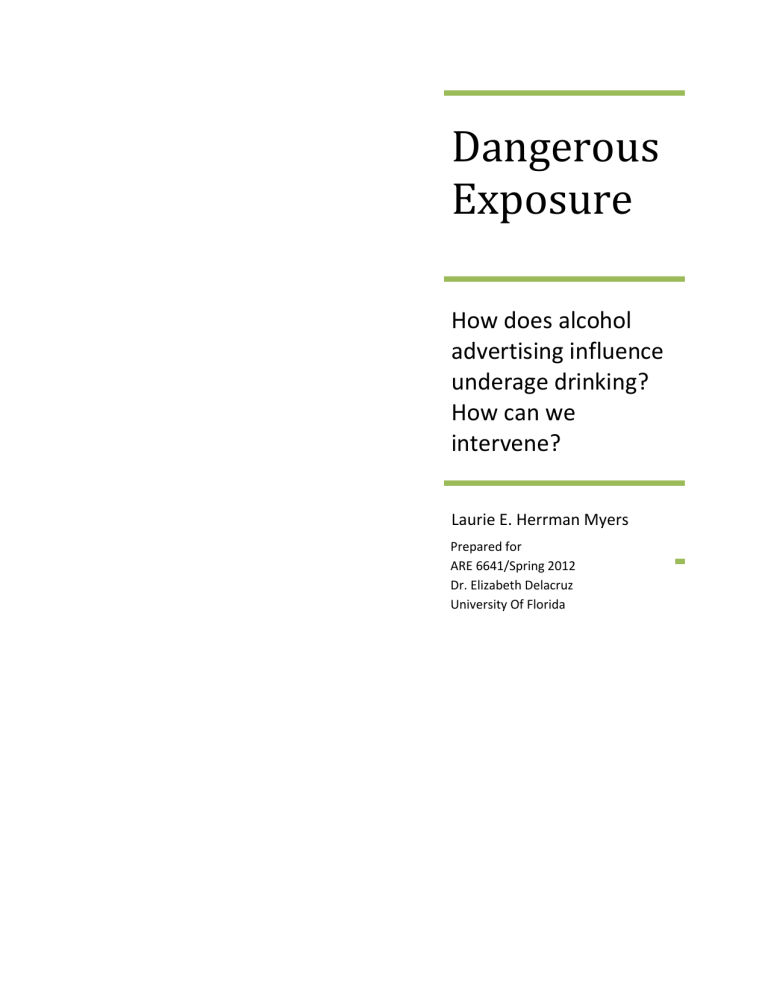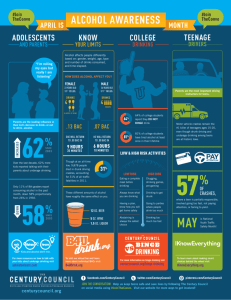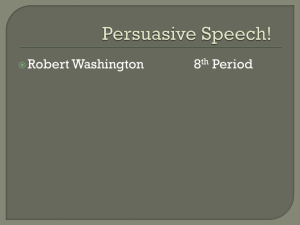deadly exposure - Laurie E. Herrman Myers

Dangerous
Exposure
How does alcohol advertising influence underage drinking?
How can we intervene?
Laurie E. Herrman Myers
Prepared for
ARE 6641/Spring 2012
Dr. Elizabeth Delacruz
University Of Florida
Cassandra by Laurie E. Herrman Myers aluminum foil and paper collage on canvas
15”x20”
About the artwork
Visual culture has been influencing humanity for as long as history has been recorded.
Since the introduction of the internet, visual media has become more pronounced. We are bombarded with visual media every day, everywhere. The artwork above was inspired by the past 70 years of external influences upon my mother and the proof that a strong, loving, caring support system can help a person discern truth and confidence in a person’s positive identity. Without such a support system, a child can fall victim to the propaganda which attempts to consume them.
How does alcohol advertisements influence underage drinking?
Happy, laughing, attractive people capture our eyes on television, demand attention from billboards, and jump off magazine pages.
“Like” a particular product on your personal social media, and that product automatically becomes part of your life. A common theme among these happy, laughing, and attractive people: they have alcohol in their hand. Life is happening to them! Excitement and joy fill their world. ‘Maybe if we drink alcohol, we can be just like these people in the advertisements!
’ Not! To make matters worse, animals, movies, and even popular musicians promote the excitement and fun associated with alcohol use —which caters to kids. Through catchy visual images, alcohol companies contribute to the problem of underage drinking.
Alcohol is the number one substance abuse problem among youth today.
There are many drugs kids can access. Prescription drugs, marijuana, meth, and heroin, are just some of the dangers readily available with little effort by kids. Yet alcohol is the primary drug kids use. According to the National Institute on Alcohol
Abuse and Alcoholism (NIAAA), “ Alcohol is the drug of choice among youth. Many young people are experiencing the consequences of drinking too much, at too early an age. As a result, underage drinking is a leading public health problem in this country”
(NIAAA, Underage Drinking , 2006, para.1).
In 2009, the Centers for Disease Control and Prevention reported: 41.8% of high school students in the US stated using alcohol at least once in the last 30 days and over 21% of youth nationwide reported drinking alcohol before age 13 (http://apps.nccd.cdc.gov/youthonline/App/Default.aspx).
Because alcoholic beverage companies make drinking seem attractive and fun, it's easy for a student to get caught up in the peer pressure of a social scene.
KidsHealth.org reports reasons kids drink:
They're curious
— they want to know what it's like to drink alcohol.
They believe that it will make them feel good; not realizing it could just as easily make them sick and hung-over.
They may look at alcohol as a way to reduce stress, even though it can end up creating more stress.
They want to feel older (2012).
Readily available and socially acceptable
Alcohol is readily available to underage youth from both commercial sources (liquor stores, convenience stores) and social sources (parties, friends, parents); youthful buyers are able to buy alcohol in approximately 30-50% of purchase attempts (Dent,
Grube, and Biglan, 2005). Alcohol is easily accessible among youth because many parents will provide it and some retailers don’t card. Over 42% of high school students that drink in the United States report they obtain alcohol from someone else giving it to them ( http://apps.nccd.cdc.gov/youthonline/App/Default.aspx
).
The study, reported by the U.S. Substance Abuse and Mental Health Services
Administration (SAMHSA) tells that 709,000 children ages 12 to 14 drink alcohol in this country. In a one-month period, the study found that more than 200,000 of those kids were given the alcohol by a parent or other adult family member.
Almost all of the kids who get their hands on alcohol get it for free; from family members, non-relative adults, other underage kids, or sneaking it from home.
(http://www.samhsa.gov/newsroom/advisories/1102163049.aspx)
Alcohol is culturally acceptable because it’s part of our history and culture. Drinking alcohol is a “rite of passage” in our culture. Peer pressure contributes to underage drinking. The first person to offer you a drink is typically a friend. Through a brochure called What it Means to You, A Guide to Action for Educators ; the U.S. Department of
Health and Human Services states, “It’s time to stop accepting teen drinking as a rite of passage and to understand the threat it poses to healthy development. It’s time to replace an environment that all too often enables underage alcohol use with an environment that discourages it” (Office of the Surgeon General, 2007, p. 9).
Advertising and Marketing influence
To reach young drinkers, alcohol companies are increasingly using the latest new media technologies . According to the article “ Alcohol Marketing in the Digital Age,
” cell
phones, social networking sites, YouTube and other features of the expanding digital world are being used to influence kids about alcohol ( HealthDay , 2010). However, this influence is not particularly honest or complete in its message.
Visual culture poses that alcohol is fun, free of consequences, and will make us good-looking and happy.
Close to 5,000 people under the age of 21 die of alcohol overuse each year, is noted by David Jernigan, associate professor at the Johns Hopkins Bloomberg
School of Public Health. Virtual worlds show all of the appeal and none of the consequences of alcohol use and undercut efforts to reduce the incidence of underage drinking. At this point, alcohol companies appear limited only by their imaginations and pocketbooks ( HealthDay , “Alcohol Marketing in the Digital
Age, ” 2010, para. 7).
Medialit.org
offers seven common myths still holding true today, written by Dr. Jean
Kilbourne (originally documented in Media & Values , 1991, Issue 54-55.). Advertisers promote alcohol through the following myths: drinking is a risk-free activity, you can’t survive without drinking, problem drinking behaviors are normal, alcohol can transform you, sports and alcohol go together, if these products were truly dangerous the media would tell us, and alcohol beverage companies promote moderate drinking
( medlialit.org
, 2011).
These myths make it is easy to understand why children, young adults, and adults alike would turn to alcohol.
Alcohol advertisements obviously promote drinking, and the number shown during family or children’s programming has increased.
Between 2001 and 2003, alcohol ads shown where programs had a 30% viewing audience of the 12-20 age group increased by 50% (Austin, 2006). The first-ever national long-term study, funded by the NIAAA, determined that greater exposure to alcohol advertising contributes to an increase in drinking among underage youth. Specifically, for every ad a young person saw, above the monthly youth average of 23, s/he drank 1% more. For every additional dollar spent per capita on advertising alcohol in local stores, kids drank 3% more (Snyder, Milici,
Slater, Sun, & Strizhakova, 2006). The survey studied the influence of alcohol advertising on youth and concluded the greater exposure to alcohol advertisements, the more that drinking increases among underage youth. The Center on Alcohol Marketing
and Youth (CAMY) research shows young people, ages 12 to 20, are exposed to more alcohol advertising per capita than adults of legal drinking age. “Excessive alcohol use kills over 4,000 kids under age 21 each year. Now we have long-term, peer-reviewed evidence that alcohol ads are contributing to this enormous public health problem,” according to Dr. David Jernigan, executive director of CAMY at Georgetown University
(Jernigan, 2006).
Evidence of influence and attraction of alcohol through advertising to youth
A study where young people responded to alcohol advertising discovered that underage youth are “drawn to music, animal and people characters, story and humor in alcohol advertising” (Chen, Grube, Bersamin, Waiters, and Keefe, 2007, para. 12). In the study, advertisements the young people liked most elicited responses of saying they wanted to purchase the brand and products presented in the advertisements. “The three most popular alcohol ads among youth in the study used animal characters as the leading actors” (Chen, Grube, Bersamin, Waiters, and Keefe, 2007, para. 12). Another study concluded that a complete ban on alcohol advertising would be the most effective for decreasing underage drinking, resulting in 7,609 fewer deaths from harmful drinking and a 16.4% drop in alcohol-related life-years lost (Hollingworth & Ebel, 2006).
Dangerous Exposure
Not everyone who drinks alcohol is an alcoholic, and not all teenagers drink. However, youth who do drink alcohol are more likely than adults to binge drink (five drinks on a single occasion), making underage drinkers a lucrative market for alcohol producers
( Media Awareness Network , 2004). Binge drinking has become more common. Over
24% of high school youth admit drinking five or more drinks in a row at least once in the last 30 days ( http://apps.nccd.cdc.gov/youthonline/App/Default.aspx
). Binge drinking used to be defined as drinking heavily over several days. Yet now, the expression refers to the heavy consumption of alcohol over a short period of time. KidsHealth.org
reports
“the generally accepted definition of binge drinking in the United States is the consumption of five or more drinks in a row by men — or four or more drinks in a row by women — at least once in the previous 2 weeks. Heavy binge drinking includes three or more such episodes in 2 week s” ( Binge Drinking , 2012, para. 4). Because the brain
continues to develop into the mid-twenties, adolescents drinking at a young age can cause changes in the structure and function of brain development. Although they drink less frequently than adults, when kids do drink, they typically drink more heavily than adults. Binge drinking is very dangerous with potentially serious, sometimes fatal, consequences. Underage alcohol use is a major cause of death from injuries among young people with approximately 5,000 people under age 21 die as a result of underage drinking (Office of the Surgeon General, 2007).
Intervention through Art Education
Alcohol is harmful and can be fatal if used incorrectly. Educating and informing kids about the true face of alcohol is crucial . A helpful tool can be media literacy.
The Center for Media Literacy (CML) is an educational organization providing leadership, public education, professional development and educational resources. CML works to help people, especially youth, develop critical thinking and media production skills needed to be fully aware of and interpret media culture of today. By exploring alcohol advertisements and creating visual expressions in response to the ads, students can become better equipped to deal with influential, powerful messages that can affect their decision making. KidsHealth.org
is yet another site providing reliable, positive, and useful information over alcohol use as well as other topics for kids and adults alike.
Giving students the opportunity to explore these and other appropriate educational sites equips them with valid resources beyond the classroom. Providing a safe, positive classroom in which students can express their concerns as well as where they have their passion, is the first and foremost obstacle in promoting a healthy lifestyle and responsible choices. CharactersUnite is also a helpful website which addresses the social damages and cultural divisions still widespread in our society today. This site is particularly dedicated to supporting and providing activities to promote understanding and acceptance of one another as well as aiding in responsible choices (USA Network,
2009). Permitting student-led discussions and project ideas like CharactersUnite provide, make art education more meaningful. The role of the teacher will prove more positive and effective through coaching and direction but with students leading. This type of student participation encourages significant, active learning which empowers
kids to make responsible choices when faced with alcohol as well as other things that may be harmful.
Influence through a quality support system
A sound quality support system is imperative when raising a child. According to
DrugFree.org
, parents have a greater impact on their children than friends, celebrities, music, TV, or the Internet. Kids who learn about drug and alcohol dangers from their parents are up to 50% less likely to use than kids who do not. “Research shows that when parents talk openly about drugs and drinking, children have better self-control and develop more negative perceptions of these risky behaviors”
( http://www.drugfree.org/prevent ).
Summary
Alcohol is a serious problem among young people today. Visual media promoting alcohol as a ‘must have’ in order to be successful and happy is commonplace.
Temptations to drink may be natural and often culturally acceptable, but the effect of alcohol advertising contributes greatly to this temptation and societal acceptance which translates into more alcohol abuse and addiction. Education can provide the intervention and prevention needed to prepare kids for the unexpected or even planned moment they experience alcohol. With the breakdown of the family unit, sometimes the only quality support a child has is a teacher. As art teachers, we have the opportunity and responsibility to make a difference in a child’s life, to help them dig deep into who they are, what they stand for, and how they can express their own identity without being controlled by visual culture. Alcohol companies target kids with appealing images which influences underage drinking. Through art classes, kids can learn to face and stand up to the lies being fed to them, ironically by adults. We can teach kids how to read and interpret visual culture in a developmentally sensitive way. My responsibility as an art educator is sometimes that of a parent, preparing my students to grow into responsible, contributing citizens who make healthy, considerate choices, including rejecting underage alcohol consumption. My goals as an art educator include: providing a safe environment which supports creative expression, problem-solving, critical thinking, and encouraging respectful, responsible individuals through formation of values and moral
character building. These goals can be accomplished through discussions and projects dealing with contemporary issues placed in the student’s lives that they deem as important. Whether it be alcohol, drugs, cussing, adoption, racism, sagging, bullying (7th grade students, 2012), my job is to prepare my students in a way that will help them be the best they can be for the next generation.
References:
Austin, E. (2006). Why advertisers and researchers should focus on media literacy to respond to the effects of alcohol advertising on youth. International Journal of
Advertising , 25 (4), 541-544. [Online Brochure]. Retrieved from http://www.drugfree.org/wpcontent/uploads/2012/02/partnership_6_components_tool_final.pdfCommunication &
Mass Media Complete database
KidsHealth. (2012, February 26). Binge Drinking . [Online Report]. Retrieved from http://kidshealth.org/teen/drug_alcohol/alcohol/binge_drink.html
Centers for Disease Control and Prevention (2011). Atlanta, GA Retrieved from http://apps.nccd.cdc.gov/youthonline/App/Default.aspx
Centers for Disease Control and Prevention (2012, February 14). 1991-2009 High
School Youth Risk Behavior Survey Data. [Online Report]. Retrieved from http://apps.nccd.cdc.gov/youthonline
Chen, M.J., Grube, J.W., Bersamin,M., Waiters, E., & Keefe, D.B. (2005). Alcohol advertising: What makes it attractive to youth? Journal of Health Communication 10:
553-565.
Dent C.W., Grube J.W., Biglan A. (2005). Community level alcohol availability and enforcement of possession laws as predictors of youth drinking. Preventive Medicine ,
40(3):355-362.
Gardner, Amanda. (May, 2010). Alcohol companies use new media to lure young drinkers: report. [Online Newsletter]. HealthDay. Retrieved from
http://www.prohealthcare.org/wellness/health-news/children/alcohol-companies-lureyoung-drinkers/
Hollingworth, W., & Ebel, B. E. (2006). Prevention of deaths from harmful drinking in the
United States: The potential effects of tax increases and advertising bans on young drinkers . Journal of Studies on Alcohol, 67:300-308.
Kilbourne, Jean. (2011) Deadly persuasion: 7 myths alcohol advertisers want you to believe. Center for Media Literacy. [Online Newsletter]. Retrieved from http://www.medialit.org/reading-room/deadly-persuasion-7-myths-alcohol-advertiserswant-you-believe
Seventh grade students. (2012, February 16). Interview by L. Myers .
[Personal
Interview]. Contemporary issues deemed important. Rolla Middle School.
The Partnership at Drugfree.org. (2011). Alcohol research and health , Volume 28,
Number 3, 2004/2005.[Online Report]. Retrieved from http://www.drugfree.org/
The Partnership at Drugfree.org (2012). 6 parenting practices. Treatment Research
Institute.
[Online Report]. Retrieved from http://www.drugfree.org/wpcontent/uploads/2012/02/partnership_6_components_tool_final.pdf
Media Awareness Network. (2010). Lessons and resources for media education.
[Online Newsletter]. Retrieved from http://www.media-awareness.ca/english/index.cfm
National Institute on Alcohol Abuse and Alcoholism (2006). Underage drinking. [Online
Brochure]. Retrieved from http://pubs.niaaa.nih.gov/publications/AA67/AA67.htm
Snyder, L.B., Milici, F.F., Slater, M., Sun, H., & Strizhakova, Y. (2006). Effects of alcohol advertising exposure on drinking among youth. Archives of Pediatrics and Adolescent
Medicine 160: 18-24 .
Substance Abuse and Mental Health Services Administration. (2011). [Online
Newsletter]. Retrieved from http://www.samhsa.gov/newsroom/advisories/1102163049.aspx
Toomey, Traci L. (2005).Youth and alcohol facts. Alcohol Epidemiology Program .
University of Minnesota Preventive Medicine, 40(3):355-362. [Online Brochure].
Retrieved from http://www.epi.umn.edu/alcohol/factsheets/youth_factsheet.pdf
USA Network. (2009, January).
Education activity guide.
[Online Brochure].
Retrieved from http://www.charactersunite.com/
U.S. Department of Health and Human Services. (2007). The Surgeon General’s call to action to prevent and reduce underage drinking: A guide to action for educators. U.S.
Department of Health and Human Services, Office of the Surgeon General .





